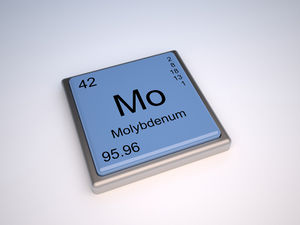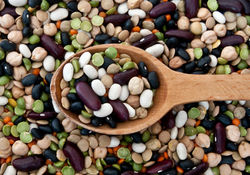Molybdenum
| See Also | Minerals |
|---|
Molybdenum is an essential trace mineral which is involved in several enzymes within the body, including the enzymes involved in uric acid formation (xanthine oxidase), alcohol detoxification (aldehyde oxidase), and sulfur metabolism (sulfite oxidase) [1].
Contents
Food Sources
The following foods have the highest concentration of molybdenum. For a more expansive list on food sources of specific nutrients visit Health Canada's Dietary Reference Intakes for Elements or USDA's National Nutrient Database
Other food sources include:[2]
- grains: whole grains
- protein sources: liver
- vegetables: cauliflower, green peas, and spinach, legumes (lentils and split peas)
Uses
The following is a list of the primary uses for molybdenum [1]
- Sulfite Sensitivity: Low levels of molybdenum can lead to increased allergic reactions to sulfites.
- Cancer Prevention: Some studies have shown that molybdenum deficiency is a contributing factor in some forms of cancer. In some areas in China and the United States where molybdenum levels in the soil and drinking water are low, rates of esophageal cancer appear to be higher. Molybdenum, as an anti-cancer agent, appears to work by playing a role in the detoxification of cancer-causing chemicals.
- Cavity Prevention: Molybdenum appears to increase the anti-caries affect of fluoride; water supplemented with both minerals appears to have a greater effect on caries prevention than fluorinated water alone.
- Wilson's Disease: Wilson's disease is a hereditary disorder whereby copper accumulates in the body due to the liver's inability to excrete copper into the bile which eventually leaves the body in the stool. Molybdenum (in the form of tetrathiomolybdate) is one of four drugs used to treat this disease. Tetrathiomolybdate forms a complex with copper and both block its absorption from the intestines or renders blood copper nontoxic. Molybdenum is an appropriate treatment for Wilson's disease, although zinc is the treatment of choice.
Deficiency Symptoms
Sulfites can be found in many food products as they serve as preservatives which prevent the growth of microorganisms. They are commonly found in wine, beer, and dried fruit. Sulfite detoxification is dependent on sulfite oxidase which is molybenum dependent. Symptoms of sulfite toxicity include [1]:
- increased heart rate
- shortness of breath
- headache
- disorientation
- nausea and vomiting
Excess Symptoms
Molybdenum toxicity is not generally seen. Generally, dosages of greater than 100mg/kilogram body weight would need to be ingested in order to see symptoms. Dosages ranging between 10-15mg/day may produce gout-like symptoms in some people due to increased action of xanthine oxidase which increases uric acid production. [1]
Prescribing Considerations
- Molybdenum is available commercially as sodium molybdate.
- The form, etrathiomolybdate, is used in the treatment of Wilson's disease.
- At low doses, molybdenum is converted; at higher doses it is rapidly excreted in the urine [1].
- The recommended dosages varies based on age and health status. To determine what your specific requirements are talk to your naturopathic doctor or other trained medical professional.
There is no official RDA for molybdenum. Here are the estimated safe and adequate ranges.
- Infant: 15-30mcg (under 6 months); 20-40mcg (6-12 months)
- Child: 25-50mcg (1-3 years); 30-75mcg (4-6 years); 50-150mcg (7-10 years)
- Adolescent - Adult (11+ years): 75-250mcg
Safety
- General Adverse Effects: gout-like syndrome and hyperuricemia (at doses of 10-15 mg/day). Supplemental doses of up to 500 mcg are generally well tolerated [3].
- Pregnancy and Breastfeeding: Should avoid supplemental intake of molybdenum above the RDA (75 mcg/day).
- Contraindications: hypersensitivity
- Precautions: Hyperuricemia and/or gout, should exercise caution with doses greater than the RDA.
Drug Interactions
- Drug Interactions include: [3]
- Acetaminophen - High doses of molybdenum may inhibit the metabolism of acetaminophen.
Nutrient Interactions
- Nutrient Interactions include: [1]
References
- ↑ 1.0 1.1 1.2 1.3 1.4 1.5 Murray Michael T (2005) Encyclopedia of Nutritional Supplements, The Essential Guide for Improving Your Health Naturally, Prima Publishing
- ↑ Medlineplus [1]
- ↑ 3.0 3.1 Hendler Sheldon S., Rorvik David (Editors) (2008) PDR for Nutritional Supplements, Medical Economics Company Inc.

